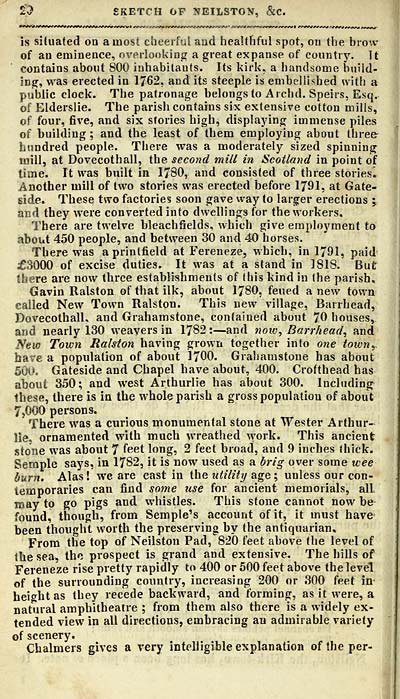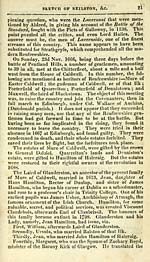Counties > Renfrewshire > 1829-1842 - Fowler's commercial directory of the principal towns and villages in the upper ward of Renfrewshire > 1830-1831
(248)
Download files
Complete book:
Individual page:
Thumbnail gallery: Grid view | List view

25 SKETCH OF NEILSTON, &C.
is situated on a most cheerful and liealtliful spot, on the brow
of an eminence, overlooking a great expanse of country. It
contains about 800 inhabitants. Its kirk, a handsome build-
iDflr, was erected in 1762, and its steeple is embellished with a
public clock. The patronage belongs to Archd. Speirs, Esq.
of Elderslie. The parish contains six extensive cotton mills,
of four, five, and six stories high, displaying immense piles
of building ; and the least of them employing about three-
hjindred people. There was a moderately sized spinning
mill, at Dovecothall, the second mill in Scotland in point of
time. It was built in 1780, and consisted of three storiesl
Another mill of two stories was erected before 1791, at Gate-
side. These two factories soon gave way to larger erections j.
and they were converted into dwellings for the workers.
There are twelve bleachfields, which give employment to
about 450 people, and between 30 and 40 horses.
There was aprintfield at Fereneze, which, in 1791, paid
;63000 of excise duties. It was at a stand in 1818. BufT
there are now three establishments of this kind in the parish,
Gavin Ralston of that ilk, about 1780, feued anew town
called New Town Ralston. This new village, Barrhead,
Dovecothall, and Grahamstone, contained about 70 houses,
and nearly 130 weavers in 1782 : — and now^ Barrhead^ and
New Town Ralston having grown together into one town^
have a population of about 1700. Grahamstone has about
50O, Gateside and Chapel have about, 400. Crofthead has
about 350; and west Arthurlie has about 300. Including
these, there is in the whole parish a gross population of about
7,000 persons.
There was a curious monumental stone at "Wester Arthur-
lie, ornamented with much wreathed \vork. This ancient
stone was about 7 feet long, 2 feet broad, and 9 inches thick.
Sample says, in 1782, it is now used as a drig over some wee
burn. Alas! we are cast in the utility age; unless our con-
temporaries can find some use for ancient memorials, all
may to go pigs and whistles. This stone cannot now be
found, though, from Semple's account of it, it must have
been thought worth the preserving by the antiquarian.
From the top of Neilston Pad, 820 feet above the level of
the sea, the prospect is grand and extensive. The hills of
Fereneze rise pretty rapidly to 400 or 500 feet above the level
of the surrounding country, increasing 200 or 300 feet in
height as they recede backward, and forming, as it were, a
natural amphitheatre ; from them also there is a widely ex-
tended view in all directions, embracing an admirable variety
of scenery.
Chalmers gives a very intelligible explanation of the per-
is situated on a most cheerful and liealtliful spot, on the brow
of an eminence, overlooking a great expanse of country. It
contains about 800 inhabitants. Its kirk, a handsome build-
iDflr, was erected in 1762, and its steeple is embellished with a
public clock. The patronage belongs to Archd. Speirs, Esq.
of Elderslie. The parish contains six extensive cotton mills,
of four, five, and six stories high, displaying immense piles
of building ; and the least of them employing about three-
hjindred people. There was a moderately sized spinning
mill, at Dovecothall, the second mill in Scotland in point of
time. It was built in 1780, and consisted of three storiesl
Another mill of two stories was erected before 1791, at Gate-
side. These two factories soon gave way to larger erections j.
and they were converted into dwellings for the workers.
There are twelve bleachfields, which give employment to
about 450 people, and between 30 and 40 horses.
There was aprintfield at Fereneze, which, in 1791, paid
;63000 of excise duties. It was at a stand in 1818. BufT
there are now three establishments of this kind in the parish,
Gavin Ralston of that ilk, about 1780, feued anew town
called New Town Ralston. This new village, Barrhead,
Dovecothall, and Grahamstone, contained about 70 houses,
and nearly 130 weavers in 1782 : — and now^ Barrhead^ and
New Town Ralston having grown together into one town^
have a population of about 1700. Grahamstone has about
50O, Gateside and Chapel have about, 400. Crofthead has
about 350; and west Arthurlie has about 300. Including
these, there is in the whole parish a gross population of about
7,000 persons.
There was a curious monumental stone at "Wester Arthur-
lie, ornamented with much wreathed \vork. This ancient
stone was about 7 feet long, 2 feet broad, and 9 inches thick.
Sample says, in 1782, it is now used as a drig over some wee
burn. Alas! we are cast in the utility age; unless our con-
temporaries can find some use for ancient memorials, all
may to go pigs and whistles. This stone cannot now be
found, though, from Semple's account of it, it must have
been thought worth the preserving by the antiquarian.
From the top of Neilston Pad, 820 feet above the level of
the sea, the prospect is grand and extensive. The hills of
Fereneze rise pretty rapidly to 400 or 500 feet above the level
of the surrounding country, increasing 200 or 300 feet in
height as they recede backward, and forming, as it were, a
natural amphitheatre ; from them also there is a widely ex-
tended view in all directions, embracing an admirable variety
of scenery.
Chalmers gives a very intelligible explanation of the per-
Set display mode to: Large image | Transcription
Images and transcriptions on this page, including medium image downloads, may be used under the Creative Commons Attribution 4.0 International Licence unless otherwise stated. ![]()
| Scottish Post Office Directories > Counties > Renfrewshire > Fowler's commercial directory of the principal towns and villages in the upper ward of Renfrewshire > 1830-1831 > (248) |
|---|
| Permanent URL | https://digital.nls.uk/85943321 |
|---|
| Description | Directories of individual Scottish counties or parts of counties. |
|---|
| Description | Around 700 Scottish directories published annually by the Post Office or private publishers between 1773 and 1911. Most of Scotland covered, with a focus on Edinburgh, Glasgow, Dundee and Aberdeen. Most volumes include a general directory (A-Z by surname), street directory (A-Z by street) and trade directory (A-Z by trade). |
|---|


